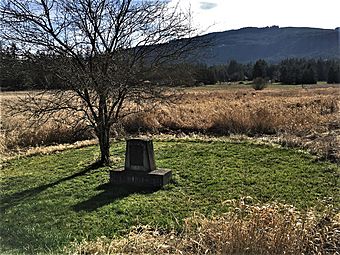Manis Mastodon site facts for kids
Quick facts for kids |
|
|
Manis Mastodon site
|
|
 |
|
| Lua error in Module:Location_map at line 420: attempt to index field 'wikibase' (a nil value). | |
| Nearest city | Sequim, Washington |
|---|---|
| NRHP reference No. | 78002736 |
| Added to NRHP | March 21, 1978 |
The Manis Mastodon site is a very old archaeological site located near Sequim, Washington. It covers about 2 acres (0.8 hectares) on the Olympic Peninsula. This amazing site was found in 1977.
During digs in 1977 and 1978, scientists found the bones of an American mastodon. What made this find special was a 13,800-year-old spear point. This point, made from another mastodon's bone, was stuck in the rib of the mastodon found here. The site was added to the National Register of Historic Places in 1978. This means it is a very important historical place.
Contents
How Was the Manis Mastodon Found?
On August 8, 1977, a farmer named Emanuel Manis was digging on his land. He was using a backhoe when he found something unusual. It was the tusks of an American mastodon!
Dr. Carl Gustafson, an archaeologist from Washington State University, led a team to dig up the site. They found a rib bone with what looked like a spear point in it. This point was made from the bone of a different mastodon.
What Did the Spear Point Show?
The bone around the point had grown, showing that the mastodon had lived for some time after being hurt. This meant the spear point did not cause its death. Dr. Gustafson believed this was the oldest sign of humans interacting with mastodons in North America.
At first, some people doubted if the point was truly made by humans. But in 2011, new studies proved Dr. Gustafson was right. The studies confirmed both the age of the point and that humans had made it.
Clues from the Mastodon's Position
Dr. Gustafson also studied how the mastodon's bones were found. The huge 6,800 kg (15,000 lb) fossil was lying on its left side. Its skull was broken and turned completely around. This could not have happened naturally. Dr. Gustafson thought humans must have moved the body.
Scientists were surprised to find a mastodon here at all. Samples of pollen from the site showed no signs of trees. Mastodons usually ate trees, so this was a puzzle.
What Else Was Found at the Site?
Above the mastodon layer, archaeologists found another interesting layer. This layer had ash from the eruption of Mount Mazama, which happened about 6,700 years ago. In this layer, they found a different type of spear point. It was a Coastal Olcott point, which are usually found in the area from about 9,000 years ago.
The site also contained bones of caribou and bison. Some of the bison bones showed signs that humans had cut them. This suggests early humans hunted and butchered these animals.
Ancient Plants at the Site
The pollen found with the mastodon bones was mostly from sedge and cattail plants. Other layers had pollen from plants like Canadian buffaloberry, blackberry, wild rose, willow, and alder. This tells us about the types of plants that grew there long ago.
Dr. Gustafson continued digging at the site for eight years. He found parts of two more mastodons. Even though he found stone tools and bone artifacts, he did not find any signs of a human camp.
Why Is This Site So Important?
Before the Manis site was found, most very old archaeological sites west of the Cascade Range were thought to be 9,000 to 6,000 years old. The Manis site is much older, dating back over 12,000 years.
In October 2011, new studies were published by Texas A&M University. They used DNA tests, CT scans, and radiocarbon dating on the mastodon and the spear point. The CT scan clearly showed that the spear point had been sharpened by human hands. The radiocarbon dating showed the site was about 13,860 to 13,763 years old.
Changing Ideas About Early Humans
For a long time, many archaeologists believed the Clovis people were the first humans in North America. They thought Clovis people lived here about 13,000 years ago. However, discoveries like the Manis Mastodon site are changing these ideas.
Sites like Monte Verde in Chile and Meadowcroft Rockshelter in Pennsylvania are older than Clovis sites. The Manis Mastodon site is about 800 years older than the Clovis people. This site, along with others, is helping scientists learn more about the very first humans in North America. The Manis Mastodon site is still the oldest archaeological site on the Olympic Peninsula in Washington State. It is also one of the oldest in all of North America.
Sharing the Discovery
During the years of digging, Emanuel Manis and his wife, Clare, welcomed over 50,000 visitors to their property. In 1978, Senator Henry M. Jackson announced that the site was added to the National Register of Historic Places.
In 2002, 25 years after the discovery, Emanuel Manis's widow gave the site to the National Archaeological Conservancy. The mastodon bones were given to the Sequim Museum & Arts in Sequim, Washington. You can see them on display there today. A copy of the bone spear point is also on display.
In November 2011, Shirley Manis, Emanuel Manis's daughter, wrote a children's picture book about the Manis Mastodon site. It includes the newest research findings.
See also
 In Spanish: Manis Mastodon para niños
In Spanish: Manis Mastodon para niños


